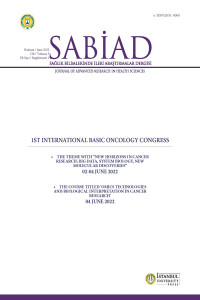Abstract
Objective: Tribbles protein (TRIB) family was first identified in Drosophila, plays role in coordinating cell division and morphogenesis. TRIB3 is one of the members of this family, its protein expression levels and patient prognosis has been examined in various studies. While TRIB3 expression was correlated with poor prognosis in hepatocellular cancer patients, its expression levels were associated with increased disease-free survival and a better response to therapy in luminal breast cancer patients. Neuroblastoma (NB) is the most common solid tumor in children and accounts for ~15% of childhood cancer‐related mortality. In the present study, we aimed the investigate the TRIB3 expression levels among NB patients and to determine if TRIB3 expression levels could be prognostic biomarker for NB. Materials and Methods: 40 children with different stages of NB were studied. The patients were staged according to criteria defined by Turkish Pediatric Oncology Group and International Neuroblastoma Staging System. Protein expression levels of TRIB3 was determined with immunohistochemical staining on paraffin sections of NB patient tissue samples. All sections were independently and blindly studied for protein expression under microscopic examination. P values <0.05 was accepted statistically significant. Results: TRIB3 expression was found to be upregulated in low grade samples and ganglioneuroblastoma samples and downregulated in neuroblastoma cells in the tissue sections of high-grade NB samples. Conclusion: While study is still ongoing, preliminary results showed that TRIB3 could be a candidate prognostic marker for NB patients.
References
- Grozescu T, Popa F. Prostate cancer between prognosis and adequate/proper therapy. J Med Life. 2017;10(1):5-12
Abstract
Objective: Tribbles protein (TRIB) family was first identified in Drosophila, plays role in coordinating cell division and morphogenesis. TRIB3 is one of the
members of this family, its protein expression levels and patient prognosis has been examined in various studies. While TRIB3 expression was correlated
with poor prognosis in hepatocellular cancer patients, its expression levels were associated with increased disease-free survival and a better response to
therapy in luminal breast cancer patients.
Neuroblastoma (NB) is the most common solid tumor in children and accounts for ~15% of childhood cancer‐related mortality. In the present study, we
aimed the investigate the TRIB3 expression levels among NB patients and to determine if TRIB3 expression levels could be prognostic biomarker for NB.
Materials and Methods: 40 children with different stages of NB were studied. The patients were staged according to criteria defined by Turkish Pediatric
Oncology Group and International Neuroblastoma Staging System. Protein expression levels of TRIB3 was determined with immunohistochemical staining
on paraffin sections of NB patient tissue samples. All sections were independently and blindly studied for protein expression under microscopic
examination. P values <0.05 was accepted statistically significant.
Results: TRIB3 expression was found to be upregulated in low grade samples and ganglioneuroblastoma samples and downregulated in neuroblastoma
cells in the tissue sections of high-grade NB samples.
Conclusion: While study is still ongoing, preliminary results showed that TRIB3 could be a candidate prognostic marker for NB patients.
References
- Grozescu T, Popa F. Prostate cancer between prognosis and adequate/proper therapy. J Med Life. 2017;10(1):5-12
Details
| Primary Language | English |
|---|---|
| Subjects | Clinical Sciences |
| Journal Section | Meeting Abstract |
| Authors | |
| Publication Date | August 9, 2022 |
| Submission Date | June 29, 2022 |
| Published in Issue | Year 2022 Volume: 5 Issue: S-1 |


